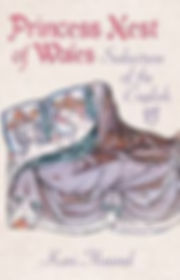Medieval Magpie Pickings (Snippets of Interesting Info)
- marilynforsyth
- Aug 26, 2020
- 3 min read
By Marilyn Forsyth
(This post was inspired by Catherine Meyrick’s blog post ‘Elizabethan Magpie Pickings’. So many interesting snippets about 16th century England!)
I’ve been vicariously inhabiting the world of 12th century Wales for a couple of years now, while I write my Rebel Daughters of Wales timeslip series. Here, for your reading pleasure, are some of my magpie pickings: 1. Women were legally, and with the sanction of the Church, allowed to be beaten by their husbands. The only condition was that the stick used for the beating must be no thicker than the husband’s thumb.
That's a thumbs down from me!

2. For women of the nobility, haute couture was a mark of high status, but such an outward show of pride was not appreciated by Christine de Pisan (medieval writer and historiographer and advocate for women's equality), who wrote: Such women “should especially avoid two things...extravagant head-dress and gowns...and the jostling that goes on when they try to get in front of each other at public functions.” LOL. Seems there have always been those types who need to get noticed.
Image courtesy of giphy

3. Speaking of medieval fashion trends...
Because dresses were so expensive the sleeves were often detachable so that the style could be changed to keep up with the latest style without incurring the cost of a whole new dress.
4. Despite common belief, medieval people actually did take good care of their teeth. Part of the reason their teeth may not have developed cavities is that sugar was a luxury item and consequently expensive. Many toothpaste recipes that have survived from that time (halitosis, it seems, has never been in vogue). One Welsh recipe says to rub teeth with a mixture of equal parts sage leaves and salt, baked until burnt and powdery. If toothpaste goes the way toilet paper has gone in the recent crazy times, you’ll now know how to make do. 😉
Image courtesy of giphy

5. Speaking of toilet paper... It’s probable that anyone who used a garderobe in a castle used either hay or linen scraps to wipe their posteriors. I know which one I’d prefer.
Image courtesy of all-free-download.com

6. The Battle of Hastings (in which William the Conqueror defeated King Harold II and the Norman dynasty came to power in England) did not take place at Hastings but at the nearby town of (the appropriately named) Battle. (We were to have visited there last month - sob!) Image courtesy of vintage-news.com

7. Speaking of William the Conqueror...
His death was just as memorable as his life (for all the wrong reasons!). Over the years of his rule, he had grown so obese that his internal organs ruptured when his protruding stomach was thrown against the pommel of his saddle. He passed away some weeks later, his body left naked on the floor while his household servants looted his belongings. Eventually his body was embalmed (despite the festering internal organs) and taken for burial, where it was discovered that his stone sarcophagus was too small to fit him. As his bloated body was being forced into place, his putrefied insides burst. The officiating clergy fled in disgust. Monty Python sketch, or what! Image courtesy of giphy

8. Princess Nest of Deheubarth was the daughter of King Rhys ap Tewdwr, mistress to Henry I, and wife of Gerald of Pembroke. She was famed not only for her beauty, but also for her involvement in an amazing escapade when her second cousin, Owain, having only just met her, fell instantly in love and abducted her. Little wonder she became known as the Helen of Wales. The question is, did she go willingly? That’s something I explore in my current wip (tentatively titled Nest’s Secret). Image of Nest in bed with Henry I

Love to Love flowers. My garden is loving the rain.
Love to Laugh at ‘Why Women Kill’. Couldn't get enough of this dark comedy on Foxtel.
Love to Learn about life in medieval times through studying illuminated manuscripts.